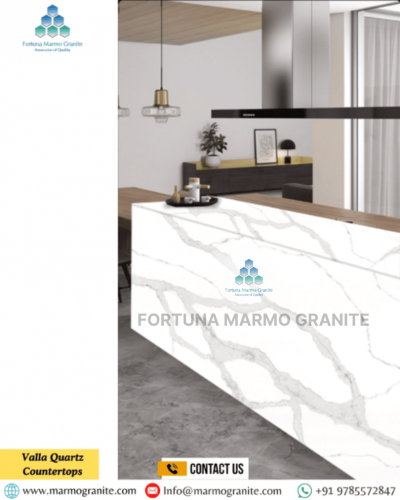How to Pair Quartz with Cabinets, Walls & Flooring: A Designer's Guide
Quartz is a top choice for modern homes thanks to its beauty, strength, and low maintenance. Made from natural stone and eco-friendly resins, it's both durable and stylish. This makes it ideal for kitchens and bathrooms. Pairing quartz with the right cabinets, floors, and wall colors is what truly brings a space together.
Start by considering undertones and texture. Warm-toned quartz pairs well with rich wooden cabinets and beige or cream walls, creating a cozy, natural feel. For a modern look, choose cool-toned quartz with white cabinets and dark flooring for bold contrast. Flooring materials such as tile, hardwood, or vinyl should match or complement your countertop. Lighting also plays a key role. It enhances the quartz's shine and brings out its depth and color.
At Fortuna Marmo Granite, we help you find the right quartz for your style. With expert guidance and a wide range of options, we make eco-friendly, elegant design simple and enjoyable.


Understanding Quartz: The Foundation of Your Design
Before choosing the perfect match, it's helpful to understand why quartz is such a popular material in modern design. Made from about 93% natural quartz mixed with eco-friendly resins and pigments, quartz is strong, stylish, and built to last. It's non-porous, so it resists stains, scratches, moisture, and bacteria—making it ideal for busy kitchens and bathrooms. Unlike natural stones like granite or marble, quartz doesn't need sealing or polishing. It's easy to clean and low maintenance. That's part of what makes it so appealing for eco-conscious homeowners.
Quartz also offers amazing design variety. Thanks to its engineered makeup, you can find it in a wide range of colors, textures, and patterns—from soft whites and earthy tones to bold veining and industrial looks. No matter your style—modern, rustic, or classic—quartz can fit right in and help bring your whole space together with ease.
The Perfect Match: Pairing Quartz with Cabinets
Defining Your Style
Your chosen design style – be it modern, traditional, farmhouse, transitional, industrial, or coastal – should guide your selections.
- Modern & Minimalist: Often favors solid or subtly patterned quartz with sleek, unembellished cabinet styles. High-gloss or matte finishes on flat-panel cabinets enhance a clean, contemporary look.
- Traditional & Classic: Marble-look quartz or neutral-toned quartz pairs beautifully with shaker, raised-panel, or inset cabinetry, creating an elegant and timeless appeal.
- Farmhouse & Cottage: Matte-finished quartz or warmer-toned quartz complements beadboard or shaker cabinets, fostering a cozy, lived-in feel.
- Industrial Chic: Concrete-look or darker quartz can be stunning with minimalist dark cabinets or open shelving, embracing raw, urban aesthetics.
Color Coordination Strategies
- Contrasting for Impact: A popular approach involves pairing light quartz with dark cabinets or vice versa to create visual drama. For instance, crisp white quartz with subtle grey veining makes a striking statement against navy blue, deep emerald green, or charcoal cabinets. Conversely, a dramatic black quartz countertop can be softened and highlighted by light oak, cream, or glossy white cabinetry.
- Monochromatic Harmony: For a serene and unified look, choose quartz and cabinet colors from the same family of hues. Soft grey quartz with darker grey cabinets creates a sleek, cohesive modern space, adding depth without strong visual breaks. An all-white kitchen with white quartz and white cabinets is a classic for brightness and spaciousness.
- Complementary Tones: Consider the undertones of both your quartz and cabinet finishes. Warm-toned quartz (e.g., creams, beiges, gold-flecked) will harmonize beautifully with warm wood cabinets (walnut, cherry) or muted green/taupe painted cabinets. Cool-toned quartz (e.g., whites with blue/grey undertones, cool greys) pairs well with cool-toned painted cabinets like soft blues or deeper greys.
Wall Color Wisdom: Quartz as Your Guide
Harnessing Undertones and Accent Colors
- Match Undertones: If your quartz has warm undertones (beige, brown, subtle yellows), opt for paint colors with similar warm hues like creamy whites, soft yellows, or earthy greens. For cool-toned quartz (greys, blues, cool whites), complementary cool paint colors such as light blues, cool greys, or muted greens will create harmony.
- Highlight Veining and Flecks: Study the subtle accent colors and veining within your quartz. These often contain hints of grey, blue, beige, silver, or gold. Choosing a wall color that echoes one of these accent colors can beautifully highlight the intricate details of your quartz, making the countertop truly pop.
Light, Dark, and Neutral Strategies
- Light & Bright: For smaller spaces or if your quartz and cabinets are dark, a lighter paint color (crisp white, off-white, light grey) will create contrast and make the room feel more open and airy.
- Adding Depth: If you have light cabinets and light quartz, a mid-tone or slightly darker paint shade can prevent the room from appearing washed out, adding necessary depth and visual interest.
- The Power of Neutrals: Neutral colors such as beiges, grays, and creams are incredibly versatile and pair well with most quartz styles. They provide a balanced backdrop, allowing the quartz to be the focal point.
- Bold Statements: For a dramatic mood, consider dark, jewel-toned walls (think deep reds, emerald greens, or navy blues). These can create a striking contrast, especially with white cabinets and either light or dark quartz, adding personality and flair.
Popular Flooring Materials and Quartz Pairings
- Hardwood Flooring: A timeless choice that complements almost all quartz types. Light hardwood (oak, maple, whitewashed) creates an airy feel and pairs well with darker or veined quartz for contrast. Medium tones add warmth, while dark hardwood (walnut, espresso) provides richness, best balanced with lighter quartz.
- Tile Flooring (Ceramic, Porcelain, Natural Stone):
- Ceramic/Porcelain Tiles: Versatile in mimicking wood, stone, or offering unique patterns. Matching undertones is key. Solid-colored quartz works well with patterned tiles.
- Marble or Porcelain Tile (Marble-Look): For a luxurious feel, pair marble-look tile flooring with neutral-toned quartz to enhance elegance.
- Vinyl and Laminate Flooring: These offer versatile and often budget-friendly options that convincingly mimic natural materials. Select vinyl or laminate that echoes the aesthetic of your quartz (e.g., wood-look vinyl with warmer quartz, stone-look laminate with cooler quartz). A matte finish on these materials can complement a sleek quartz surface.
- Bamboo Flooring: Its unique grain and texture add visual interest. Lighter bamboo works well with light quartz for an open feel, while darker bamboo creates a sophisticated look with darker quartz.
The Designer's Final Touch: Achieving Cohesion
- The Three-Color Rule: A simple yet effective guideline is to stick to three primary colors for your main elements: one for countertops, one for cabinets, and one for flooring. This prevents the space from becoming visually chaotic.
- Mix Textures Thoughtfully: If your quartz has a smooth, polished finish, consider introducing texture through your cabinets (e.g., a wood grain or beadboard) or flooring (e.g., textured tile or a rustic wood finish). This adds visual interest without overwhelming the space.
- Leverage Lighting: Always consider how both natural and artificial lighting will interact with your chosen materials. Lighting can dramatically alter the appearance of colors and textures. View samples in your space at different times of the day before making final decisions.
- Samples and Mood Boards are Your Best Friends: Before committing, obtain physical samples of your quartz, cabinet finishes, and flooring materials. Arrange them together in your space, creating a mood board. This allows you to visualize the combination in real-world conditions.
- Consult a Professional: If you're uncertain about your choices or embarking on a major renovation, don't hesitate to consult with an interior designer or kitchen specialist. Their expertise can provide invaluable guidance and ensure a truly refined outcome.
Conclusion
How to Pair Quartz with Cabinets successfully pairing quartz with cabinets, walls, and flooring requires more than just an eye for color—it demands a deep understanding of design principles, surface compatibility, and how different elements interact within a space. Quartz, known for its remarkable durability and visual appeal, offers a wide spectrum of shades and patterns that can enhance the personality of any interior—be it a contemporary kitchen with crisp white cabinets and sleek grey flooring, or a warm, traditional space adorned with wooden cabinetry and soft, neutral wall tones. How to Pair Quartz with Cabinets The key lies in striking a visual balance—choosing quartz that either complements or subtly contrasts with your cabinetry, ties in with wall colors, or grounds the flooring in a harmonious way.
Indian Granite Supplier At Fortuna Marmo Granite, we take pride in helping our customers craft spaces that are both functional and visually inspiring. Our expert team understands how crucial it is to choose the right stone that not only meets aesthetic goals but also performs well over time. With an extensive portfolio of premium quartz slabs and a strong commitment to quality, craftsmanship, and customer satisfaction, we guide homeowners, interior designers, and architects through every step of the process. How to Pair Quartz with Cabinets Whether it's a full home renovation or a small design upgrade, Fortuna Marmo Granite stands as your trusted partner, delivering not just superior stone, but a complete design experience that reflects elegance, individuality, and lasting beauty.

